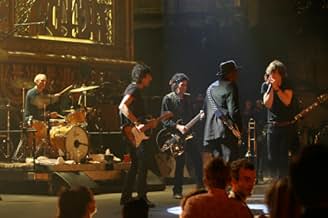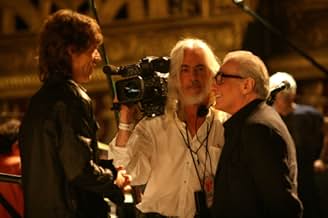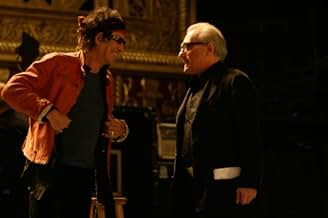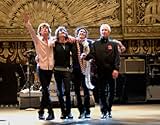A career-spanning documentary on The Rolling Stones, with concert footage from their "A Bigger Bang" tour.A career-spanning documentary on The Rolling Stones, with concert footage from their "A Bigger Bang" tour.A career-spanning documentary on The Rolling Stones, with concert footage from their "A Bigger Bang" tour.
- Awards
- 4 nominations
Kent S. Smith
- Self - The Rolling Stones: trumpet
- (as Kent Smith)
Jack White
- Self
- (as Jack White III)
Storyline
Did you know
- TriviaBruce Willis can be seen in the audience wearing a yellow hat.
- Quotes
Keith Richards: Hey. Hey, Clinton. I'm "Bushed"!
[laughs]
- Crazy creditsFrom end credits: Every day the Clinton Foundation works to make a difference by finding real and tangible solutions to some of the world's most pressing challenges, including HIV/AIDS, climate change, global poverty, child obesity and many more. For more information visit www.clintonfoundation.org
- ConnectionsEdited into The Rolling Stones: Shine a Light Movie Special (2008)
- SoundtracksI Can't Be Satisfied
Written by Muddy Waters (as McKinley Morganfield)
Performed by Muddy Waters
Courtesy of Watertoons Music, administered by BUG
Courtesy of Epic Records, By Arrangement with Sony BMG Music Entertainment
Featured review
I saw the Rolling Stones live last year for the first time and I was blown away. I've been a Stones fan for decades but have never had any interest in stadium rock concerts with their huge crowds and tiny stars on stage. The few stadium shows I've attended were always mediocre experiences. But the Stones' Bigger Bang tour changed my mind.
For one, the enormous video screens make every seat great. Beyond that, it was the Rolling Stones that won me over. Rocking songs, incredible performances, unbelievable energy, and every one in the crowd dancing and singing the whole show. And these guys are in their sixties! Watching 'Shine a Light' on IMAX at times made me feel like I was actually at a live Stones concert, but then I kept feeling that something key was missing. And it was.
Martin Scorsese covered the two explosive shows at the Beacon Theater in New York with 18 cameras but he somehow missed getting the band. As expected, lead singer and ringmaster, Mick Jagger, gets the most screen time, with guitarist, Keith Richards, coming in a not too distant second. And then there's Ron Wood, the second guitarist, and some might argue, the better soloist, He has juicy moments on screen, but is shockingly absent time and again when soloing, the camera instead lingering on a prancing Jagger or posing Richards.
And where is drummer Charlie Watts? Watching 'Shine a Light' one might think the Stones had backing tracks instead of a live drummer. Watts is the quiet one (who doesn't dye his hair) but he's the backbone of their sound, keeping time, holding it down while the boys jump around. I kept wanting to see shots of Watts, not only for the variety of imagery and the visual reinforcement that there really is a live drummer hitting the cowbell on 'Honky Tonk Women,' but also because he's an original Rolling Stone. Sadly, there are only a handful of very brief clips featuring Watts, and just as few wide shots of the whole band on stage. And Watts is not the only one nearly absent from the movie.
Although the original members are Jagger, Richards, Watts and Wood (Wood joined in 1974 so he's not actually an original Stone), they tour with a number of key support musicians, including bass player, Daryl Jones (who's worked with them since 1994), a keyboardist, a horn section and three back-up singers. However, except for some brief interplay between Jagger and the back-up singers, the other musicians are absent from the film. It's not so unusual to relegate non-member, support players to minor roles in concert movies, but to avoid them altogether is baffling and frustrating.
The support musicians may not be Rolling Stones but they are a part of the band. They are playing the music and adding to the sights and sounds on stage. But 'Shine a Light' mostly kept them in the dark. This isn't how a real concert is experienced. In concert the other players are seen and often featured in the spotlight as soloists. But time and again in 'Shine a Light', we hear a piano riff, a sax solo, a horn section blast, a bass run, but we never actually see who's playing. We neither get full nor medium shots, nor even close-ups of hands playing. We don't even get quick cuts of the support players, as one might see interspersed regularly throughout most filmed live concerts today. Instead, we see lingering shots of Jagger and Richards, sometimes so close you can see the brown behind Jagger's teeth, while a saxophone or some other player wails somewhere off-camera. The Stones sound is some much more than guitar, bass, drums and vocals. A concert is so much more than the starring players, but you don't get that from this film. It's as if the film makers had tin ears.
This is baffling because they had 18-camera shooting the action. So the film makers either didn't get the coverage, or they decided in the editing room not to include the other players. Bad decision. This gives the movie, the Stones concert experience, a frustrating myopic feel. I kept wanting to see what I was hearing, but couldn't. I kept wanting to get a visual of the focal point in the song and on stage, but it was not delivered. Even one of the few times Jaggar plays harmonica is off-camera. This left me feeling short-changed.
Ultimately, 'Shine a Light' is slightly claustrophobic, with all its medium and close shots. It rarely opens up to show the entire band on stage. The film suffers as a result, as wide shots would have provided much needed breathing room, offering a more open perspective, and also providing the myriad tight shots with context. We do see the interplay between Jagger and Richards, or between Richards and Wood, but we don't see the whole band working together as a unit. And ultimately that's what a live Stones show, or any live rock show is all about--a group of individuals performing together as a band. Even if Scorsese decided that the film was all about the four Stones, he could have easily divided the enormous screen into quads, now and again, so we could see the four Stones working their magic simultaneously in a multi-screen format. This is common place today and highly effective.
It's baffling that with all the resources at hand and experience behind him, Scorsese didn't quite deliver the goods. It's as if his infatuation with the visages of Jagger and Richards blinded him from showing us the Rolling Stones. 'Shine a Light' is enjoyable for sure, but suffers from a limited vision.
For one, the enormous video screens make every seat great. Beyond that, it was the Rolling Stones that won me over. Rocking songs, incredible performances, unbelievable energy, and every one in the crowd dancing and singing the whole show. And these guys are in their sixties! Watching 'Shine a Light' on IMAX at times made me feel like I was actually at a live Stones concert, but then I kept feeling that something key was missing. And it was.
Martin Scorsese covered the two explosive shows at the Beacon Theater in New York with 18 cameras but he somehow missed getting the band. As expected, lead singer and ringmaster, Mick Jagger, gets the most screen time, with guitarist, Keith Richards, coming in a not too distant second. And then there's Ron Wood, the second guitarist, and some might argue, the better soloist, He has juicy moments on screen, but is shockingly absent time and again when soloing, the camera instead lingering on a prancing Jagger or posing Richards.
And where is drummer Charlie Watts? Watching 'Shine a Light' one might think the Stones had backing tracks instead of a live drummer. Watts is the quiet one (who doesn't dye his hair) but he's the backbone of their sound, keeping time, holding it down while the boys jump around. I kept wanting to see shots of Watts, not only for the variety of imagery and the visual reinforcement that there really is a live drummer hitting the cowbell on 'Honky Tonk Women,' but also because he's an original Rolling Stone. Sadly, there are only a handful of very brief clips featuring Watts, and just as few wide shots of the whole band on stage. And Watts is not the only one nearly absent from the movie.
Although the original members are Jagger, Richards, Watts and Wood (Wood joined in 1974 so he's not actually an original Stone), they tour with a number of key support musicians, including bass player, Daryl Jones (who's worked with them since 1994), a keyboardist, a horn section and three back-up singers. However, except for some brief interplay between Jagger and the back-up singers, the other musicians are absent from the film. It's not so unusual to relegate non-member, support players to minor roles in concert movies, but to avoid them altogether is baffling and frustrating.
The support musicians may not be Rolling Stones but they are a part of the band. They are playing the music and adding to the sights and sounds on stage. But 'Shine a Light' mostly kept them in the dark. This isn't how a real concert is experienced. In concert the other players are seen and often featured in the spotlight as soloists. But time and again in 'Shine a Light', we hear a piano riff, a sax solo, a horn section blast, a bass run, but we never actually see who's playing. We neither get full nor medium shots, nor even close-ups of hands playing. We don't even get quick cuts of the support players, as one might see interspersed regularly throughout most filmed live concerts today. Instead, we see lingering shots of Jagger and Richards, sometimes so close you can see the brown behind Jagger's teeth, while a saxophone or some other player wails somewhere off-camera. The Stones sound is some much more than guitar, bass, drums and vocals. A concert is so much more than the starring players, but you don't get that from this film. It's as if the film makers had tin ears.
This is baffling because they had 18-camera shooting the action. So the film makers either didn't get the coverage, or they decided in the editing room not to include the other players. Bad decision. This gives the movie, the Stones concert experience, a frustrating myopic feel. I kept wanting to see what I was hearing, but couldn't. I kept wanting to get a visual of the focal point in the song and on stage, but it was not delivered. Even one of the few times Jaggar plays harmonica is off-camera. This left me feeling short-changed.
Ultimately, 'Shine a Light' is slightly claustrophobic, with all its medium and close shots. It rarely opens up to show the entire band on stage. The film suffers as a result, as wide shots would have provided much needed breathing room, offering a more open perspective, and also providing the myriad tight shots with context. We do see the interplay between Jagger and Richards, or between Richards and Wood, but we don't see the whole band working together as a unit. And ultimately that's what a live Stones show, or any live rock show is all about--a group of individuals performing together as a band. Even if Scorsese decided that the film was all about the four Stones, he could have easily divided the enormous screen into quads, now and again, so we could see the four Stones working their magic simultaneously in a multi-screen format. This is common place today and highly effective.
It's baffling that with all the resources at hand and experience behind him, Scorsese didn't quite deliver the goods. It's as if his infatuation with the visages of Jagger and Richards blinded him from showing us the Rolling Stones. 'Shine a Light' is enjoyable for sure, but suffers from a limited vision.
- How long is Shine a Light?Powered by Alexa
Details
- Release date
- Country of origin
- Language
- Also known as
- Shine a Light: The IMAX Experience
- Filming locations
- Production companies
- See more company credits at IMDbPro
Box office
- Gross US & Canada
- $5,505,267
- Opening weekend US & Canada
- $1,488,081
- Apr 6, 2008
- Gross worldwide
- $15,773,351
- Runtime2 hours 2 minutes
- Color
- Sound mix
- Aspect ratio
- 1.85 : 1
Contribute to this page
Suggest an edit or add missing content







































